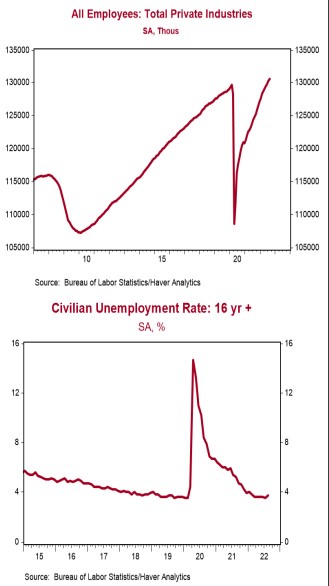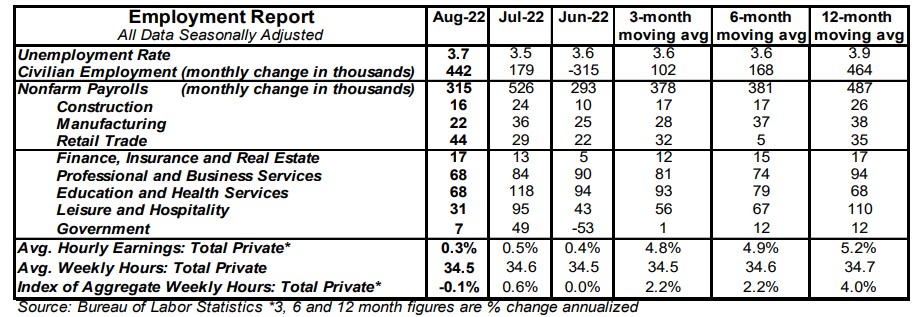- Nonfarm payrolls increased 315,000 in August, narrowly beating the consensus expected 298,000. Payroll gains for June and July were revised down by a total of 107,000, bringing the net gain, including revisions, to 208,000.
- Private sector payrolls rose 308,000 in August but were revised down 52,000 in prior months. The largest increases in August were for professional & business services (+68,000, including temps), health care & social assistance (+62,000), retail (+44,000), and leisure & hospitality (+31,000). Manufacturing increased by 22,000 while the government rose by 7,000.
- The unemployment rate rose to 3.7% in August from 3.5% in July.
- Average hourly earnings – cash earnings, excluding irregular bonuses/commissions and fringe benefits – rose 0.3% in August and are up 5.2% versus a year ago. Aggregate hours declined 0.1% in August but are up 4.0% from a year ago.
Implications:
A mediocre report on the labor market, which, given the circumstances, is exactly what the Federal Reserve wanted to see. Nonfarm payrolls rose 315,000 in August, which narrowly beat consensus expectations. However, downward revisions to June and July reduced the net gain to 208,000. The best news in the report was that civilian employment, an alternative measure of jobs that includes small-business start-ups, rose 442,000 while the labor force increased 786,000. As a result, the labor force participation rate rose to 62.4%, tying the high so far in the recovery. Also as a result, the unemployment rate rose to 3.7% versus 3.5% in July. But increases in the unemployment rate due to more jobs and faster growth in participation are not something to worry about. Perhaps the best summary of the jobs report came from wages. Average hourly earnings rose 0.3% in August. That’s good news in that we estimate consumer prices were up about 0.1% in August, so that means “real” (inflation-adjusted) wage gains rose in August itself. However, 0.3% per month isn’t enough to keep up with the inflation trend. Average hourly earnings are up 5.2% from a year ago while consumer prices are likely up about 8.2%. The worst news in today’s report was on hours. Average weekly hours per worker declined to 34.5 in August from 34.6 in July, tying the lowest level in the last couple of years. As a result, even though more people were working in August, the total number of hours worked declined by 0.1% for the month. We like to follow total wages paid, which is based on average hourly pay and total hours worked. Total wages increased 0.2% in August, which was the smallest gain in eighteen months. No, the US economy isn’t in a recession. But this doesn’t mean we won’t fall into one sometime in the next year or so. Overly loose monetary policy has generated an inflation problem that’s worse than any we’ve had in four decades. Eventually, the Fed needs to get tight to bring down inflation, and, with a lag, that tightness will cause a recession.





